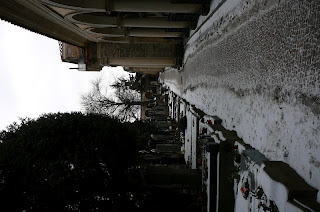In the morning, I took a 30-minute walk to Vyšehrad, the castle ruins south of the Old Town. There isn’t much of the castle left, but there’s a gorgeous cathedral on the grounds. Inside, it has the most amazing gilding and decoration. The colours of the stained glass windows were phenomenal. The church also contained a collection of pontifical treasures (chalices, monstrances, reliquaries), all made of precious metals and stones. The most common jewels were garnets, which the Czech Republic is famous for.
Click on the pictures to enlarge them!
 |
| The view going up to Vyšehrad. |
 |
| Stairs to the church. |
 |
| Doors to the church. |
 |
| The church from the outside. |

 |
| St. Martin's rotunda |
Outside the church is a cemetery where some very famous Czech people are buried. It was very peaceful, and there were even some green leaves still growing! In February! I found the graves of both Dvořák and Smetana! It’s really amazing to be there, seeing the place where these people were actually there. I’ve played lots of Dvořák’s music, but I hadn’t really thought that I would be visiting the place where he lived and worked.
 |
| In the cemetery. |
 |
| There were some beautiful monuments. |
 |
| Dvořák. |
 |
| View of the church from the cemetery. |
 |
| Smetana. |

In the afternoon, I walked to the Old Town where I visited some famous astronomical locations. First stop was the Kepler museum, located in the ground floor of the building where Kepler lived. He was an astronomer who lived from 1571 to 1630, and discovered two important planetary laws while working in Prague. (I did research on his work last year, so I was really excited to visit!)
 |
| Entrance to the Kepler museum. |
 |
| Kepler's house. |
Afterwards, I walked to the main square where I saw the famous astronomical clock – the third oldest in the world and the oldest that is still working! An astronomical clock displays astronomical information in addition to the time (often charting the position of the Sun and the Moon). This one in Prague dates back to 1410. Across the square, I visited the Týn Church, where I had the chance to see the gravestone of Danish astronomer Tycho Brahe.
 |
| The astronomical clock. |
 |
| Explanation of the different components. |
 |
| Týn Church across the square. |
Finally - goulash for supper! It was delicious. J





















Thanks for the comment! (Is this someone from home? I never know with the Anonymous status...but I love receiving comments! :-)
ReplyDelete:-0 Cool clock, amazing 1410!
ReplyDelete